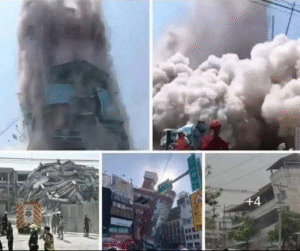The city once stood proud. Now it whispers through rubble. A magnitude roared beneath the crust, and in seconds, steel bent like reeds, glass shattered like dreams, and homes—those sacred vessels of memory—were torn open to the sky. Streets became fault lines. Towers folded into themselves. The skyline, once a signature of ambition, now resembled a jagged heartbeat flatlining.
Smoke curled from broken windows. It wasn’t just fire—it was grief made visible. People wandered, barefoot and stunned, clutching photographs, pets, each other. Sirens wailed like mourning mothers. Dust coated everything, even the sun, which hung dim and indifferent above the chaos.
A child’s shoe lay alone beside a collapsed school. No one dared touch it. It was a symbol now—of innocence interrupted, of futures rerouted. Volunteers dug with bare hands. Rescue dogs barked at silence. Hope flickered in the eyes of those who refused to leave, who believed someone was still beneath the debris, waiting.
Temples cracked. Churches crumbled. Mosques split. Faith itself seemed shaken. Yet people gathered in open fields, praying not for answers but for strength. The earth had spoken, but the human spirit whispered back: We are still here.
In the aftermath, kindness bloomed like wildflowers. Strangers shared food. Artists painted murals on broken walls. A violinist played amid ruins, her notes rising like incense. The city, though fractured, began to pulse again—not with electricity, but with empathy.



